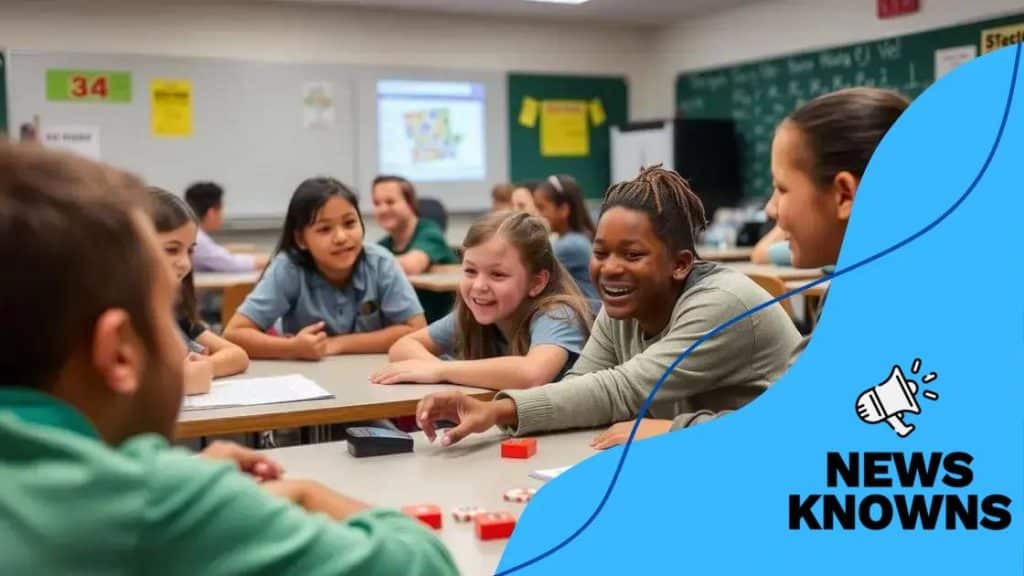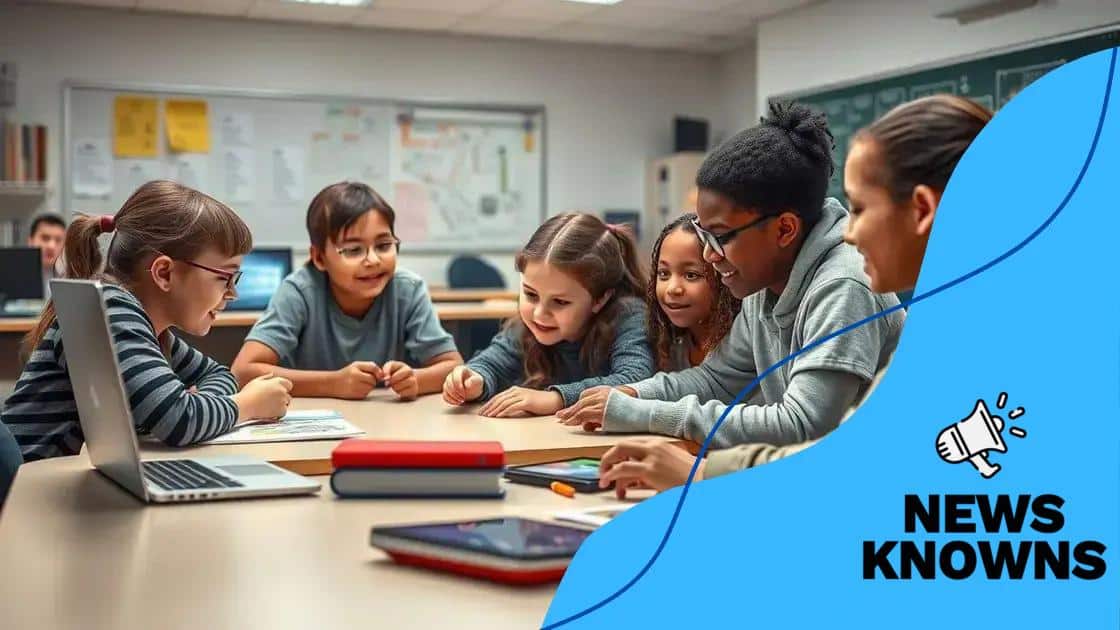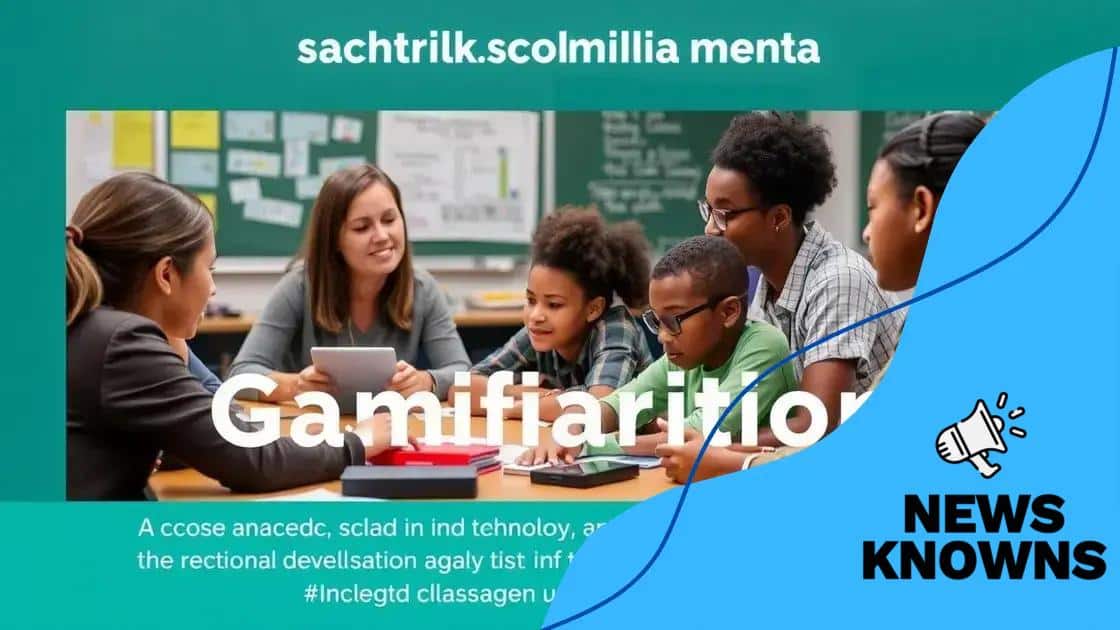The role of gamification in increasing student engagement

Anúncios
The role of gamification in increasing student engagement focuses on using game elements to enhance motivation, collaboration, and learning experiences, leading to improved academic performance and a more enjoyable classroom environment.
The role of gamification in increasing student engagement is gaining attention in educational circles. Have you ever wondered how game mechanics can create dynamic learning environments? Let’s dive into this engaging topic.
Anúncios
Understanding gamification and its principles
Understanding gamification is essential in today’s educational landscape. By integrating game design elements into learning, educators can enhance engagement levels among students. The principles of gamification center around motivation, rewards, and user experience, which are key to revolutionizing how students interact with their studies.
Key Principles of Gamification
Several principles guide effective gamification. These elements can be tailored to fit various educational contexts. Here are a few fundamental aspects:
- Motivation: Gamification taps into innate motivators, pushing students to engage.
- Feedback: Immediate feedback helps learners adjust their strategies and promotes improvement.
- Rewards: Systems of rewards encourage sustained engagement through recognition of achievements.
- Challenge: Providing challenges that are both achievable and stimulating motivates learners to push their limits.
Implementing gamification successfully requires understanding these principles and balancing them to fit the learning environment. For example, challenges should be aligned with learning goals while allowing students room to explore and collaborate. One effective method to achieve this is by integrating collaborative team-based tasks. Such activities can utilize gamified elements, providing both rewards and challenges that foster camaraderie among peers.
Anúncios
Creating Engaging Experiences
A critical aspect of gamification is designing experiences that resonate with students. Gamified environments should reflect students’ interests, making learning enjoyable. Incorporating storytelling elements can transform mundane tasks into immersive learning experiences.
Another essential factor is ensuring the activities are not purely competitive. While competition can increase motivation, emphasizing personal growth and collaboration is crucial for long-term engagement. Students are more invested in environments where they feel safe to express themselves, ask questions, and learn from their mistakes.
In conclusion, understanding gamification and its principles can significantly contribute to enhancing student engagement. By focusing on motivation, feedback, rewards, and creating positive experiences, educators can foster a vibrant learning atmosphere that inspires students to achieve their best.
How gamification enhances learning experiences

How gamification enhances learning experiences is a fascinating topic. When educators implement game elements in their teaching, they not only engage students but also transform the way they learn. Incorporating gamification into lessons creates an interactive environment that fosters exploration and collaboration.
Engagement through Fun
One of the primary ways gamification enhances learning is by making education enjoyable. When students see learning as a game, their motivation increases. They are more likely to participate actively and take risks, knowing that failures can lead to valuable lessons.
- Increased Motivation: Game-like elements keep students interested in their work.
- Competitiveness: Friendly competition can encourage participation and effort.
- Feedback Mechanisms: Students receive instant feedback, which helps them adjust their strategies and improve.
- Sense of Achievement: Completing tasks or leveling up gives students a sense of progress.
Additionally, gamification encourages teamwork. When students work together in teams or compete against each other, they develop collaboration skills. For example, a classroom might host a quiz competition where students must work in pairs to answer questions. This activity not only makes learning engaging but also promotes social interaction.
Customization and Personalization
Another important aspect is how gamification allows for personalization. Students can often choose their own learning paths or control the pace at which they learn. This method helps cater to different learning styles. For instance, visual learners might prefer interactive games, while auditory learners benefit from challenges that include storytelling.
Furthermore, personalized experiences create a stronger connection to the material. When a student makes choices about their learning, they are likely to feel more involved and invested in the content. This involvement helps them grasp concepts more deeply and retain information longer.
Ultimately, gamification enhances learning experiences by making education more engaging, collaborative, and personalized. These improvements lead to better understanding and retention of knowledge among students.
Case studies of successful gamification in classrooms
Case studies of successful gamification in classrooms provide valuable insights into how this approach transforms learning. Schools using gamification have reported remarkable improvements in student engagement and performance.
Example: Classcraft
One notable success story is Classcraft. This program turns the classroom into a game where students can create avatars and earn rewards for positive behavior. By incorporating a point system, students are motivated to participate actively. Teachers have noted increases in collaboration and a decrease in behavioral issues as students become more invested in their learning experiences.
- Increased Engagement: Students show higher interest in lessons.
- Improved Behavior: Positive reinforcement promotes respectful interactions.
- Collaboration: Team challenges boost peer support.
- Academic Achievement: Gamification correlates with better test scores.
Another impressive example comes from a school in California that integrated gamification into its science curriculum. The educators used a game-based platform to create exciting lessons about ecology. Students worked in teams to complete quests related to environmental science topics. This approach made complex subjects more approachable and engaging. The results were impressive, with students demonstrating a deeper understanding of the material.
Example: Kahoot!
Kahoot! is another successful tool that shows how gamification can enhance classroom experiences. It allows teachers to create quizzes that students answer on their devices in real-time. This interactive format encourages friendly competition and keeps students alert. Reports indicate that classes using Kahoot! experienced a noticeable boost in participation and enthusiasm.
In these environments, students feel empowered to engage with the material. As they compete for points and recognition, they become active learners rather than passive recipients of information. The incorporation of gamification strategies has proven to be beneficial in fostering a love of learning.
Challenges educators face with gamification

Challenges educators face with gamification can be significant. While the benefits are clear, implementing game elements in the classroom is not without hurdles. Understanding these challenges is crucial for educators looking to adopt gamification.
Integration with Curriculum
One major challenge is integrating gamification into existing curricula. Teachers often struggle to align game mechanics with educational goals. Finding ways to make game elements fit seamlessly into lessons requires careful planning. Educators need to ensure that the focus remains on learning outcomes and not just on game mechanics.
- Curriculum Alignment: Ensuring activities meet learning standards.
- Time Constraints: Limited time to implement new strategies effectively.
- Resource Availability: Access to technology can be a barrier.
- Training: Need for professional development in using gamification.
Another challenge is the need for sustained student interest. While many students initially excite about gamification, keeping their motivation high over time can be difficult. Educators must continually find new ways to engage students, which requires ongoing creativity and adaptation.
Equity and Access
Equity in access to gamification strategies is another significant concern. Not all students have the same access to technology or support at home. This discrepancy can lead to gaps in engagement and learning. Teachers need to be mindful of these differences and find inclusive ways to apply gamified learning.
Moreover, some students may not respond well to competitive elements of gamification. Understanding individual learning styles is essential. Teachers should consider how to adapt activities to meet diverse needs. Encouraging a collaborative environment can help alleviate some issues with competition.
Overcoming these challenges requires patience and support from school administration. Educators will benefit from sharing experiences and best practices. By working together, they can develop effective gamification strategies that enhance student engagement and learning.
Future trends in gamification for education
Future trends in gamification for education are exciting and hold great promise. As technology continues to evolve, new methods of engaging students are emerging. One significant trend is the increased use of virtual reality (VR) in the classroom. VR can create immersive learning experiences, allowing students to explore new worlds and concepts in a way that traditional methods cannot.
Personalized Learning Experiences
Another important trend is the growth of personalized learning through gamification. By using data analytics, educators can tailor learning experiences to individual student needs. This approach ensures that each student progresses at their own pace, making education more effective. Combining gamification with personalized learning could lead to higher retention rates and greater student satisfaction.
- Adaptive Learning Technologies: Softwares that respond to individual learning styles.
- AI-Driven Assessments: Tools that evaluate student performance and suggest improvements.
- Interactive Content: Gamified quizzes, simulations, and challenges align with student interests.
- Cross-Platform Learning: Accessing educational content across different devices enhances engagement.
Moreover, integrating gamification with social media platforms is another trend to watch. Schools may encourage students to collaborate and share their achievements on social networks. This engagement can foster a sense of community among students and motivate them to participate more actively.
Focus on Soft Skills
Future educational trends will also emphasize the development of soft skills through gamification. Employers increasingly value skills such as communication, collaboration, and problem-solving. By incorporating these into gamified learning experiences, educators can better prepare students for the workforce.
Additionally, the use of game mechanics to foster resilience and adaptability is essential. Challenges and setbacks are part of learning, and gamified environments can teach students how to handle failures gracefully, teaching perseverance along the way. These essential life skills will be crucial in the ever-changing job market.
As these trends develop, educators must keep pace with innovative practices to leverage the full potential of gamification in education. By embracing these changes, schools can create engaging and meaningful learning experiences that resonate with today’s learners.
FAQ – Frequently Asked Questions about Gamification in Education
How can gamification improve student engagement in classrooms?
Gamification improves student engagement by incorporating game-like elements, such as rewards and challenges, making learning more enjoyable and motivating.
What are some tools used for gamification in education?
Popular tools for gamification include Classcraft, Kahoot!, and Quizizz, which help create interactive and fun learning experiences.
Can gamification help in developing soft skills?
Yes, gamification promotes skills like teamwork, communication, and problem-solving by encouraging students to work collaboratively in engaging environments.
What are the potential challenges of implementing gamification in schools?
Challenges include integrating gamification with existing curricula, ensuring equity in access to technology, and maintaining student motivation over time.





